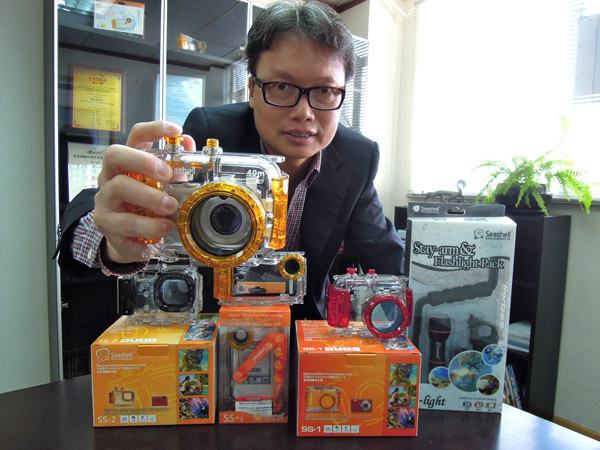Universal waterproof camera case A big hit with Europeans and Americans
Inventors and innovators, who are often coming up with new ideas, and they should know how to protect their intellectual property rights to position their products as pioneer in the market. William Yim Huilam, president of Zear Corp Ltd, for digital cameras, developed the universal waterproof camera case. Before it was introduced to the market, Yim applied for several patents for the product, covering its design and functionalities. The patents have proven their validity from IP infringements. Within 2 years, the company has sold 30,000 to 40,000 of its patented universal waterproof camera cases.
Yim was originally in the business of advanced technology trading. His eureka moment came four years ago while he was attending a conference on optics/medical in Italy and was surprised to find that despite high costs, the makers managed to get inspiration on new products that have been produced locally. This got him thinking. "Why can't this be done in Hong Kong?" He got a few suggestions from local Italian innovators; he outlined motives for his business plan: He wants to create a private brand that is profitable. Patent applications mean profits of the business can be protected. Despite high labor, logistics and management costs could balance out investments. "Returning to Hong Kong after these enlightening observations, I started to think how to use patented products to open up new paths."
 |
Yim loves scuba diving and is bursting with numerous ideas. Ten years ago, he won an Industrial Design Award in Hong Kong. "Many water sports enthusiasts want to record the underworld and take snapshots for their memories. Yet, the quality of photos taken by waterproof cameras on the market is not appealing," said Yim. "So I thought of designing a case that would be suitable for different cameras, such as a universal waterproof camera case three years ago," he said.
Yim emphasizes all concepts and designs of the new products remained confidential and only management knew details of his research. Before promoting the products, the inventor should first apply for a provision patent of utility model in Hong Kong and China and PCT provision patent in the US. To increase protections, the innovator should apply for diversify patents covering different aspects of designs. Filing patent applications formally in all those jurisdictions where provision patent utility model were applied are a necessity. Once applications are filed, the innovator could launch products to the markets.
The Seashell universal waterproof camera case is made of polycarbonate, a lightweight high performance plastic, and can be used at a depth of up to 40 meters (130 feet). It is shock proof up to a height of one meter and can be used in temperatures as cold as minus 10 degree Celsius and as hot as 60 degrees Celsius. The core-patented technology must have push button adjustments. "The position of the push button has been designed with precision instruments; it is adjusted by an 'actuator,' which allows it to be used with on-off switches and buttons for large and small cameras."
He insisted one patent is never sufficient as full protection for a new product. To strengthen patents protection for Seashell, the company applied patents on various aspects of the product, such as the shape, design of the rim, the lock, and others. "It is lucky that in Hong Kong, we hired a lawyer to specialize in intellectual property trading, which facilitates the patent applications process struggle with no hassles.
He revealed the company has sold between 30,000 to 40,000 universal waterproof camera cases in the past two years, Over 50 percent of the orders come from the US and the rest from Europe and Southeast Asian markets. "Such remarkable sales reports are a great motive to a private brand in Hong Kong," Yim added.
However, Zear Corp. faced one unanticipated event during a product promotion in the market. Yim shared an incident at a Photographic products exhibition in Cologne, Germany. He found a mainland Chinese company had infringed on its patented waterproof camera case and promoted the product to buyers at the same fair. He reported it to fair management. He called his attorney and asked to prepare legal documents to the organizer of the exhibition for a dispute application. The fair organizer confiscated products that were in violation of patent documents and the incident reached a settlement. Yet, this was not the end of the story; Seashell discovered that the same mainland Chinese company had violated IP rights again. "We went through our Hong Kong attorney and collected evidence of their business in Hong Kong, and took them to court," Yim said. "The court ordered the company to stop selling the products," he added, "the experience has shown us the importance of intellectual property rights."
To expand its production lines, Seashell extended the principle behind the patented waterproof camera case to produce waterproof cases for smart phones. The company has developed its own photography App for the iPhone. "With the waterproof case on your phone, photographic application and functions could still be accessed as they normally would." He said. "The company has registered the brand name trademark 'Seashell', to protect its business developments."
As for the cost of applying for a patent, Yim said the process was expensive and could cost as high as HK$100,000. Fortunately, Small and Medium-sized Enterprises (SMEs) should consider applying for the Patent Application Grant funding scheme, set up by the Innovation and Technology Commission of the Hong Kong government, for which companies and individuals are eligible. "All applications for functional patents and inventions with technology elements are eligible. But no grants are given for external or cosmetic designs. The implementation agent of the scheme, that is, the Hong Kong Productivity Council, will conduct a patent search-cum-technical assessment to ensure there is a reasonable chance of obtaining a patent."
